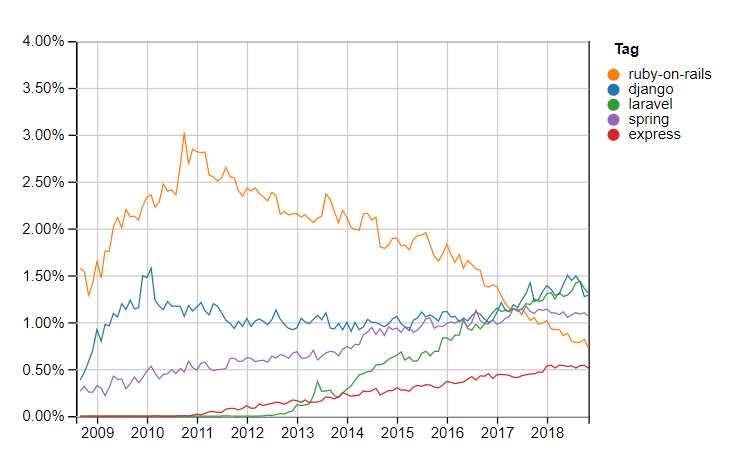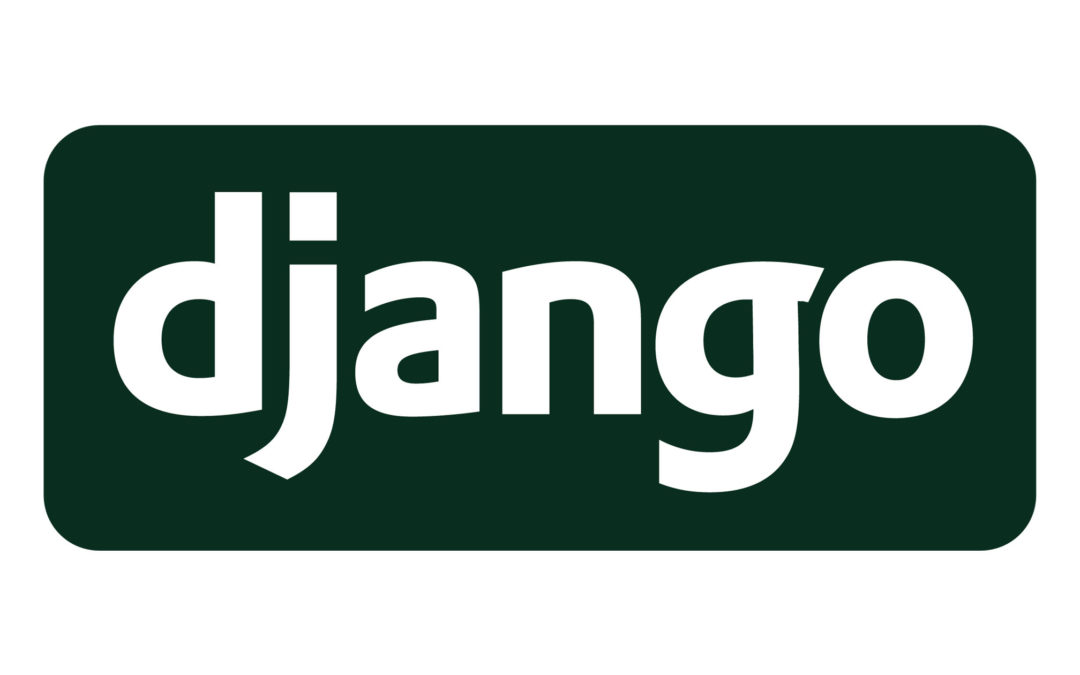Our past year predictions came true: Python officially became the language of the year in 2018. The technology continues its epic ascension and gains ground among web developers in various niches.
According to the recent stats from StackOverflow, Python accounts for about 11% of the questions at the beginning of 2019. Now it finally overtakes Javascript, the definitive leader of the previous five years. Also, as for the TIOBE index, it takes a stable 4th position behind Java, C, and C++.
Online brands are befriending Python, too. This especially applies to the non-tech brands that immediately fall in love with the language due to its simplicity, versatility, and object-oriented structure. Python’s code is known for its impressive readability, what can’t be said about the rest of technologies. Just take a look at this basic comparison of Python, Java, and C++ code when it comes to displaying text.
Python
print("Text output in Python!")Java
public class JavaVsPython {
public static void main(String[] args) {
System.out.println("Java Vs Python!");
}
}
C++
#include <iostream>
using namespace std;
int main()
{
cout<<"C++ Vs Python!";
return 0;
}
Despite Python’s ease of use, it’s not always reasonable to utilize the raw language to build simple web applications from scratch. For this, you have frameworks.
In short terms, frameworks are the collections of programming modules applicable to the majority of software development cases. You don’t need to come up with every string of code in your app when you have a pre-made solution offered by the framework.
Read more: Language, Framework, CMS: What is the difference?
Beyond any doubt, Django is the most versatile framework written in Python. Let us explain to you what exactly it is and why you should consider building your web app with its help.
What is Python Django Framework?
Python Django is a free and open-source framework with a model view controller pattern (also called model-view-template by Python enthusiasts), primarily meant for fast and hassle-free creation of websites and web applications. The MVC concept allows to separate data and algorithms from the visual part and therefore contributes to less intimidating software development.

Django is among the most loved frameworks among back-end developers. 58.3% of StackOverflow annual report respondents already use and are going to keep using Django in their programming practice. The demand for Django learning is extremely high as well, according to the graph shown above. In 2019, Django is competing with Laravel, while the Ruby-on-Rails framework’s popularity rapidly declines.
Pros and Cons of Python Django
Django is a choice of many reputable brands including Instagram, Spotify, and Youtube because of its vast possibilities. This framework is a good fit for almost every web application. However, for some of them, it’s the best existing solution, while for others — not quite. There is a short list of Django’s major strengths and weaknesses, which you should learn before making your final choice.
- Django is a batteries-induced framework. This means that it offers a variety of libraries and packages of reusable code you can apply for your own project. If you hire a Python developer, they will spend twice less time to get the job done on Django, while you — twice less money.
- Django provides a well-structured admin panel with permissions and authentication module.
- It’s highly scalable and flexible. You can easily add or remove components of your project as well as extend your experience with hundreds of plugins.
- The framework features a handy object-oriented mapper that ensures smooth interaction with databases.
- It offers high-grade security by default, sparing you from implementing security solutions by yourself.
- Django ensures very easy post-project maintenance, as it uses a simple Python code in its core;
You get a nice boost for SEO with Django in-built SEO tools, which is especially essential for your website success on the internet. - Django has a friendly community and detailed documentation, so you’ll never be left alone in a mess.
- Django works best for medium-size projects, but is slightly less suitable for small and big ones. It’s overly complex for the first and too monolithic for the second.
- For now, Django doesn’t support Websockets and therefore can’t be used for building real-time apps.
- Template errors are usually not reported so you may end up in a long retrieval of the reason why your app doesn’t work. Or even fail to identify the mistake at all.
- Django can’t handle multiple requests at the same time.
- The huge code database can be somewhat intimidating for newbies.
- Website/application speed issues after the integration of more modules and components may occur, if not configured properly.
Django vs. Laravel
Laravel bears the same level of popularity as Django, if not the greater one. Wondering about which technology to choose for your web application, you have probably repeatedly encountered this name. Moreover, for a good reason: Laravel is the best PHP framework meant for building large-scale projects.
Currently, PHP is the most widespread language when it comes to web development. Over 80% of all the web is built with PHP. However, despite PHP’s prevalence, Python is still our favorite due to its simpler syntax, better package management, and of course, Django! Let’s see the facts speaking for themselves.
Examples of Apps Built with Python Django
Django is loved not only by startups but by huge international brands as well. Are you ready to hear about 3 renowned projects that proudly run their backend on Django? Let’s fire away!
Instagram is the largest photo-sharing social network up to date. According to SimilarWeb statistics, it is the 5th largest website on the entire web. The service can’t be defined as small or even medium-size application, it is a massive project with all its grave consequences.
Although Instagram is powered by dozens of technologies, Django is used as its mobile backend. The Python-based framework contributes to data processing and interaction management, which is pretty much job to do there. This makes the framework an extremely important component of everyone’s favorite application.
PREZI
Prezi is a web-based presentation builder, which you can use someday as a viable alternative to standard Microsoft Powerpoint. The main advantage of this app is that you can create non-linear presentations which are not limited to slides. Instead, Prezi offers a large canvas to place graphs, pictures, and other elements with a “zoom” option used to highlight them.
However, what’s even more impressive from the perspective of today’s topic, Prezi is fully developed on Django from the very launch of the app. Maybe that’s the primary reason why they have no problem to scale further, as now software is used by over 100M people worldwide.
SPOTIFY
Spotify is a #1 streaming service in the world. Even with the arrival of Apple Music and Google Play Music, Spotify has 191M subscribers, while their competition features only 50M and 40M users respectively.
The pioneer of the music streaming industry relies heavily on Python in both backend software development and machine learning. They also combine the simple language with the Django framework, following Python’s “don’t repeat yourself” and “quick development” principles.
Python Django Framework Use Cases
Django works best for building web-based large-scale applications. It can be a social network filled with tons of media (like Instagram), a highly customizable app for media creation (video editing, presentation making, etc.), or a scalable e-commerce website that requires high-grade security and seamless integration of payment systems.
It can be anything on the web that has excellent potential to grow up to millions of daily users. So if you have ambitious plans and are going to build an application like that — Django can be the perfect option of your choice.
At the same time, Django lacks flexibility. Django is too monolithic and almost forces you to build things not the way you want, but the way Django allows you.
Django is barely suitable for building small and lightweight apps as well. Its functionality is overloaded with tons of features that are not necessary for a simple web app. So if you need a small application, we recommend you to go with Flask, a Python micro-framework designed precisely for such tasks.
Either way, Python seems to be the best option to build your first web application with, as it has relatively short learning curves.
However, don’t take this the wrong way. Even such a simple language as Python requires months to learn and years to master. Also, if you ain’t ready to spend time and effort on learning, you can entrust professionals with your idea.
Software Outsourcing — The Fastest Way to Build Your Dream App
Successful people delegate. They prefer doing things they enjoy and are great at. If you have an idea for a web app but don’t enjoy web development — outsource it and get the job done in a few weeks.
Python and Django are the core competencies of specialists at Edgica. Feeling like the days of ordinary web apps are over? Well, then we can build something that this world has never witnessed with innovative IoT, blockchain technologies. Your wildest dreams come true with Edgica — fill up the contact form and let’s do some Django magic!



